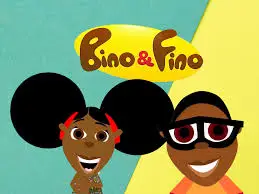“You don’t need Pixar polish to change a child’s world, just characters who look like them and a story that speaks to their heart.”
In the heart of Abuja in 2007, animator Adamu Waziri watched as Nigerian children stared at screens filled with foreign cartoons, none reflecting their skin, culture, or worldview.
Children’s brains learn fastest between ages 0–6, yet almost no show showed them themselves. That realization sparked Bino & Fino, not with Disney budgets, but with boundless vision and cultural pride.
Characters Beyond the Screen
Bino and Fino aren’t just animated siblings; they’re mirrors. A brother and sister living in a modern African city, flanked by their grandparents and guided by Zeena the magical butterfly, teach kids about African history, languages, math, and everyday life in their world.
No talking animals or mystical flora, just food like jollof rice, patterns that echo Ankara fabrics, and Fino’s iconic Afro-puff hairstyles.
Teaching Without the Gloss
Yes, Bino & Fino lacks the budget for lush Pixar visuals. But what it does have is authenticity. The pilot episode breaks down Nigeria’s Independence Day in simple terms. Other episodes teach counting in Igbo and Yoruba. This isn’t fluffy education, it’s identity reinforcement during children’s most impressionable years.
Waziri’s ethos? “Stop waiting for Disney to do it. Do it yourself.”CNN And “Disney-level” it doesn’t need to be, just mirror African children and uplift them.
From a Dream to Global Distribution
Despite humble beginnings, Bino & Fino soared quickly. By 2012, the series aired on Sky TV in the UK. Now, it’s available in 15 countries, streaming via YouTube, Hopster, KLM flights, Pebble TV, and even university libraries via Kanopy.
It’s dubbed in English, French, Igbo, Yoruba, Hausa, Swahili, Twi, Portuguese, Dutch, and German.

Beyond Animation Merch That Matters
Bino & Fino has transcended the screen by becoming a cultural touchstone and yes, a merchandising success. The official shop offers plush toys, birthday party decor, books like The Great Walls of Benin, clothing, and downloadable episodes.
Parents gush about how seeing brown-skinned characters talking in their accent makes a difference. One mom shared how her kids learned Igbo counting while playing with plushies, reenacting episodes in their living room.
A Generation Inspired
The real magic of Bino & Fino lies in its ripple effect. West African kids seeing themselves animated inspired some to pursue creativity themselves.
While hard numbers are scarce, stories abound: kids who felt seen now sketch, animate, or dream. Schools and cultural centers report more interest in African-themed storytelling. The series redefined what representation can achieve even without a “Disney budget.”
Why Bino & Fino Matters
Representation Trumps Style: High-quality visuals can be replaced but representation can’t.
Accessible and Relatable: African languages, foods, and everyday scenes create instant connection.
Educational and Fun: Geography, history, language all wrapped in light-hearted stories.
A Launchpad for Talent: Sprouting confidence, imagination, and local storytelling ambition in young hearts.
Your Turn: Join the Conversation
What’s most impactful for your kids or kids you know? Studios like Bino & Fino prove that when you build characters that children recognize, you build heroes that inspire.
Which character from Bino & Fino sparks the most connection for your child?
What kind of African-focused animated content do you want to see next?
If you had a small budget but a big message, what story would you create?
Drop your thoughts because representation isn’t a luxury, it’s essential.